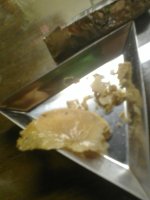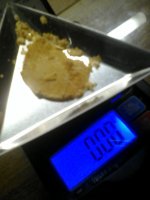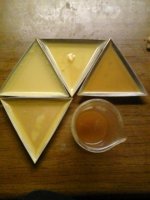Tangarine_Dreams
Rising Star
so xlogp says noxide is insol in naphtha and heptane...
yet i get beautiful orange to yellow spice using both naphtha and heptane.
when the spice is dissolved in boiling heptane there is an orange layer at the bottom of the beaker, and boiling yellow heptane above that.
if u let it settle, most of the kicked up orange oil falls down and the heptane becomes more clear-yellow than yellow.
very quickly there after dmt starts to fall out. if i siphon off this layer right before it cools that much and evap or fp, i get a ring of orange in the middle at the very bottom, a layer of pale yellow above that and all across the beaker, then a ring of oils around the beaker at the very top with a few xtals sticking to the sides.
the only way i can clean it up is by saturating hot naphtha with this mixture of orange oil and yellow spice. then let it coolsome and the oil sticks to the jar, then decant. if i do this enough i get pure cake on the bottom, crystal on top yellow pice. but its still ALWAYS yellow. anytime i use hot heptane it is too. it remains yellow unless i frz it veeery cold and dont touch it for 5 or so days. even then, when i move it from the frzr it stirs up too much to make totally clear.
can heptane be used when its not boiling?
im using klean strip vmp and bestine heptane.
but seriously, what chemical is this yellow? if u tell me oxide i will again point to the nexus wiki stating it is insol.
the other day i took some of this orange stuff that collects on my jars. i took a 10ml beaker and added 4ml water, some naoh, 4ml of nephtha, and come of this reddish stuff. i mixed it up. the naphtha picked up a slight tinge of color, prolly left over 'dmt'. the water picked up no color, and this reddish orange stuff formed liquid bubbles between the water and naphtha... its not bark. it doesn't dissolve in water. i filter out bark with a cotton bit and a pipette in the manner people do with heroin.
im not too inclined to make my spice white as i believe i prefer the effect of yellow, but my friends dont all feel the same way.
if its not oxide then what is it? jungle spice? gimmy a chemical and not a speculative phantom psychedelic. ive seen so much contradictory info on what the other alkaloids are.
im using pink powdered ebay bark btw
yet i get beautiful orange to yellow spice using both naphtha and heptane.
when the spice is dissolved in boiling heptane there is an orange layer at the bottom of the beaker, and boiling yellow heptane above that.
if u let it settle, most of the kicked up orange oil falls down and the heptane becomes more clear-yellow than yellow.
very quickly there after dmt starts to fall out. if i siphon off this layer right before it cools that much and evap or fp, i get a ring of orange in the middle at the very bottom, a layer of pale yellow above that and all across the beaker, then a ring of oils around the beaker at the very top with a few xtals sticking to the sides.
the only way i can clean it up is by saturating hot naphtha with this mixture of orange oil and yellow spice. then let it coolsome and the oil sticks to the jar, then decant. if i do this enough i get pure cake on the bottom, crystal on top yellow pice. but its still ALWAYS yellow. anytime i use hot heptane it is too. it remains yellow unless i frz it veeery cold and dont touch it for 5 or so days. even then, when i move it from the frzr it stirs up too much to make totally clear.
can heptane be used when its not boiling?
im using klean strip vmp and bestine heptane.
but seriously, what chemical is this yellow? if u tell me oxide i will again point to the nexus wiki stating it is insol.
the other day i took some of this orange stuff that collects on my jars. i took a 10ml beaker and added 4ml water, some naoh, 4ml of nephtha, and come of this reddish stuff. i mixed it up. the naphtha picked up a slight tinge of color, prolly left over 'dmt'. the water picked up no color, and this reddish orange stuff formed liquid bubbles between the water and naphtha... its not bark. it doesn't dissolve in water. i filter out bark with a cotton bit and a pipette in the manner people do with heroin.
im not too inclined to make my spice white as i believe i prefer the effect of yellow, but my friends dont all feel the same way.
if its not oxide then what is it? jungle spice? gimmy a chemical and not a speculative phantom psychedelic. ive seen so much contradictory info on what the other alkaloids are.
im using pink powdered ebay bark btw



